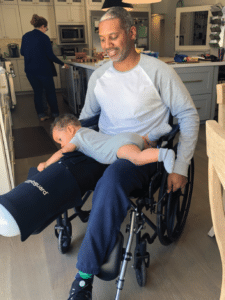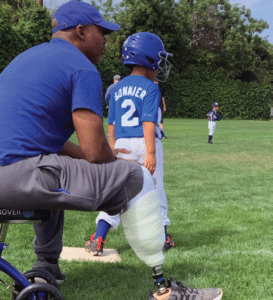In a recent interview with the Amputee Coalition, Brandon Sonnier, television writer, producer, and director shared the story of his limb loss journey. Through the resources and support he received from the Amputee Coalition after amputation, he rebuilt his life and continues to work in his field In a short Q&A, he described his experience and spoke about how he is thriving today. Here’s what he had to say:
Q: How did your life change when you experienced limb loss or limb difference?
 I became a right below the knee amputee three years ago. I was in an accident on set while filming the finale of the first season of the television show I created and executive produced, L.A.’s Finest. During a stunt, a car went out of control and hit a shipping container I was standing behind. The container crushed my foot. I was rushed by ambulance to the hospital and during the ride I could tell by the EMTs’ responses that something was severely wrong. I insisted on keeping my foot, so I underwent a nine-hour surgery to have it reconstructed.
I became a right below the knee amputee three years ago. I was in an accident on set while filming the finale of the first season of the television show I created and executive produced, L.A.’s Finest. During a stunt, a car went out of control and hit a shipping container I was standing behind. The container crushed my foot. I was rushed by ambulance to the hospital and during the ride I could tell by the EMTs’ responses that something was severely wrong. I insisted on keeping my foot, so I underwent a nine-hour surgery to have it reconstructed.
However, I experienced grave complications including blood infections while trying to save the foot and when it became clear that the reconstructive surgery failed, my wife and I decided to have my leg amputated. I became an amputee on the third day I was in the hospital.
I’m certain every amputee has had doctors tell them “it’s going to be fine” because prostheses are amazing. That is not entirely true. One of the things I think amputees should know is that it’s okay if things are not fine. One of the greatest challenges for me was coming to terms with this. After three years, I’m still in the process of accepting the fact that my amputation is forever, and it will never be the same as before. However, different does not have to mean bad. It’s just different.
Q: What were your challenges? What were your successes?
The hardest part for me, everyday, continues to be waking up and having to put my prosthetic device on, acclimate my limb to walking around in it, and pushing through the initial pain to go out and greet my children. I have four young children and I try to be as present in their lives as I was before the amputation because their lives shouldn’t change just because mine did. Sometimes I struggle with questioning myself, “how do I get through the rest of this day?” I see a therapist once a week to help talk through my uncertainty and insecurities and say out loud the things that are the hardest for me. Sometimes putting words to the challenges I’m facing helps make them seem more manageable. I have learned to push through and move on, not ignoring that everything has changed, and that things are more difficult. But accepting there’s more to be done on the other side, so I get up and get things done. I hold on to my sense of purpose, which helps with the feeling of loss that comes from an amputation. Although it’s a challenge, I reframe my thinking to focus on the things I get to do. I get to play with my kids. I get to coach their little league baseball teams. I get to do my job still.
In my job, I produce, write, and direct television shows. It’s a job that has you on your feet constantly all day long, but I’m able to continue working through changes I have made to the ways I do things.
Coaching my kids’ little league baseball has become one of my passions. It has very much helped me keep going after I had my leg amputated. It was at the beginning of little league season when the accident happened. And two weeks later, I was back at practice in my wheelchair, coaching the kids. The kids have all accepted me coaching with one leg and they’ve all just moved on and it’s helped me to move on too. With my prosthetic device, I’m on my feet and walking around. It’s been three years and I still can’t run, but that’s okay because I can show the kids how to do it; I can still stand next to them and get into a baseball ready position, the way I used to do.
Q: How did your discovery of the Amputee Coalition impact your life?
 One of the first things I remember when I was in the hospital is waking up after the surgery and my prosthetist gave me an introduction to how prostheses work and left on my bed a welcome packet. The packet said, “welcome to the amputee community,” and included information such as the inMotion magazine. I remember having a sense of relief. I felt a lot of emotions at that time but knowing there were resources to help me get through this new phase of my life as an amputee really helped me find a sense of calm in those beginning moments. I am grateful for Amputee Coalition’s welcome packet that is delivered to hospital rooms of recent amputees.
One of the first things I remember when I was in the hospital is waking up after the surgery and my prosthetist gave me an introduction to how prostheses work and left on my bed a welcome packet. The packet said, “welcome to the amputee community,” and included information such as the inMotion magazine. I remember having a sense of relief. I felt a lot of emotions at that time but knowing there were resources to help me get through this new phase of my life as an amputee really helped me find a sense of calm in those beginning moments. I am grateful for Amputee Coalition’s welcome packet that is delivered to hospital rooms of recent amputees.
Q: How do you thrive and remain resilient?
I am where I am today because of the love and support of my family and friends, chief among them my wife, Sarah. I have learned to use the resources available to me and continue to educate myself. I read the inMotion magazine article about phantom limb pain, so I contacted my surgeon and told him I was having a lot of pain. It turned out I was a great candidate for TMR surgery to address phantom limb pain. I had the surgery, and it is helping me. This progress happened because I allowed myself to first accept my new normal, then to get better at it, and look for ways that would help me thrive in this new life.
Everyone can advocate for themselves. The more we say, the more people will listen. The more we advocate for ourselves, the more people will have to stop and think about how the environments we work in, live in, and play in affect all people. I am dedicated to making sure that everyone has equal access. We don’t tend to think about those with limb loss and limb differences until it happens to us or someone we know or someone we love. But we should all be aware of what other people in our society are going through and what challenges they may face just to get through their day. With that knowledge will come empathy and compassion and hopefully policy change and workplace change, and all the things that can happen when you take a second to actually see the people around you.

